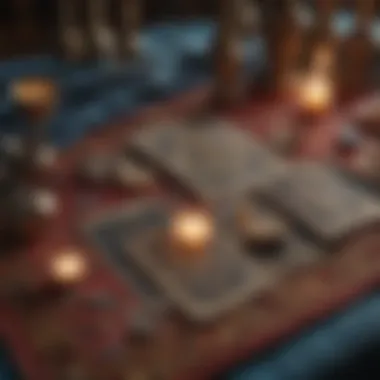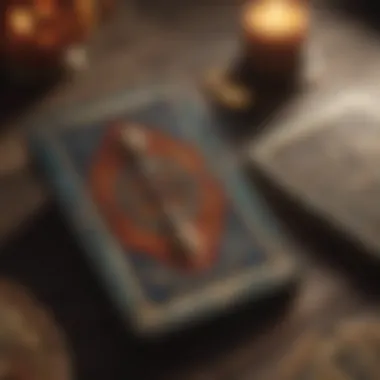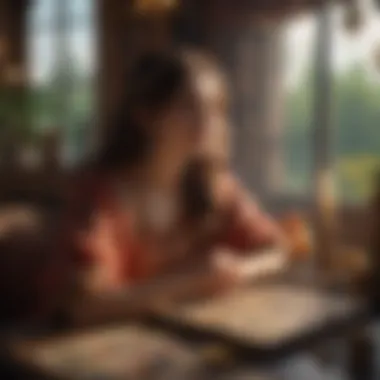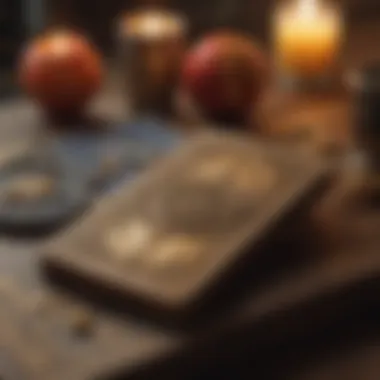Mini Tarot Readings: A Guide for Personal Growth


Intro
Mini tarot readings offer a unique approach to accessing intuitive insights and deeper understanding of life's situations. While traditional tarot readings may involve a comprehensive spread of cards, mini readings streamline this process, making it more approachable for both practitioners and clients. This guide will explore the essential aspects of mini tarot readings—covering methodologies, interpretations, and their significance in personal development—providing a valuable resource for astrologers, tarologists, and esoteric enthusiasts alike.
Understanding how mini tarot readings fit into the broader landscape of divination can be transformative. They offer succinct, impactful insights that can guide decisions and self-discovery. As attention spans wane in our fast-paced world, the allure of quick yet meaningful guidance grows. This article aims to unravel the advantages of mini readings and their place within the celestial realm of astrology.
Horoscope Predictions
Horoscope predictions serve as one layer of insights that can complement mini tarot readings. By examining the astrological backdrop, practitioners can provide depth to the messages derived from the cards. Here we will briefly explore the daily, weekly, and monthly horoscopes as they relate to mini tarot readings.
Daily Horoscope
Daily horoscopes offer a snapshot of influences affecting each zodiac sign. They help to understand the immediate environment and how it resonates with personal circumstances. Integrating insights from a mini tarot reading with daily predictions can enhance clarity and focus.
- Aries: Focus on communication today.
- Taurus: Creativity may lead to solutions.
- Gemini: Emotional insights can emerge.
- Cancer: Nurture personal relationships.
- Leo: Confidence can attract opportunities.
- Virgo: Organize to reduce stress.
- Libra: Seek balance in partnerships.
- Scorpio: Transformative experiences may arise.
- Sagittarius: Personal growth is highlighted.
- Capricorn: Practical steps bring success.
- Aquarius: Experimentation opens new paths.
- Pisces: Dreams may provide guidance.
Weekly Horoscope
Weekly horoscopes present a broader overview, providing guidance for challenges and opportunities. Aligning these insights with mini tarot readings ensures a more holistic interpretation of upcoming events.
For example, if a mini reading emphasizes taking action, and the weekly horoscope shows favorable conditions for bold moves, the clarity of direction becomes pronounced.
Monthly Horoscope
A monthly horoscope encapsulates significant astrological shifts that can impact all signs. They highlight trends and energies to navigate through life, offering context for the themes that emerge in mini tarot readings.
The interplay of these predictions with tarot cards can reveal deeper lessons or affirmations for personal growth during a specific month.
"Incorporating horoscope insights can provide a multi-faceted approach when engaging with tarot, enhancing the clarity of readings."
Thus, while mini tarot readings distill information into digestible insights, surrounding horoscopes enrich those insights, fostering understanding and intuitive guidance. Each realm provides a distinct lens, offering a pathway for personal evolution. The nuances of how these two modalities interact will be explored further in subsequent sections.
Understanding Mini Tarot Readings
Mini Tarot readings are a condensed form of traditional tarot practices. They offer a focused approach to gaining insights and reflections about various aspects of life. This section delves into the significance and components that make mini tarot readings an invaluable tool for both practitioners and seekers.
Mini Tarot readings are crucial for allowing individuals to connect with their intuition in a more digestible way. They simplify the art of divination, making it accessible to those who may be intimidated by larger, more complex spreads. Furthermore, they cater to our fast-paced lives, offering straightforward guidance without becoming overwhelming. These brief sessions can be particularly beneficial for busy individuals seeking clarity about specific questions or situations.
Incorporating mini readings into daily routines encourages consistent reflection. The focus is often on immediate concerns, which promotes a habitual connection to intuitive practices. Over time, this not only helps in addressing pressing matters, but deepens one's understanding of their relationship with the tarot.
Defining Mini Tarot Readings
Mini Tarot readings typically involve one or a few cards drawn to answer a specific question or provide quick guidance. Their compact nature allows practitioners to extract meaningful insights without the need for expansive explanations. The clarity is especially valuable in moments when time is limited or emotional energy is low.
These readings can take many forms, such as a one-card draw for immediate insights or a three-card spread to explore past, present, and future influences. The key lies in their simplicity, which enhances their effectiveness. For both seasoned readers and novices, mini readings create a bridge between daily life and deeper spiritual exploration.
Historical Context of Tarot
The history of tarot can be traced back to the 15th century, originating in Europe. Tarot cards were first created for playing games before their mystical associations emerged. Over time, these cards evolved into tools for divination, often imbued with complex symbolism and rich imagery.
The transition from game to oracle reflects changing societal perspectives about fate, destiny, and the human experience. Initially, the esoteric dimension of tarot was reserved for a select few, but with the rise of interest in the occult during the late 19th century, public fascination grew. This led to the popularization of tarot as a method of self-exploration and guidance among wider audiences.
As practitioners began to develop various methodologies, including different spreads, the need for more concise readings became evident. Thus, mini tarot readings emerged as an accessible means to cultivate intuition and gain insight, bridging the historical depth of tarot with contemporary practices. The historical context of tarot plays a significant role in understanding its adaptability and relevance in today’s spiritual landscape.
Components of Tarot
Understanding the components of tarot is essential for conducting mini tarot readings. The tarot deck is not merely a collection of cards; it embodies a system of archetypes that can offer deep insights into our lives. By grasping the different components, practitioners can enhance their readings, predict future events, identify present circumstances, and understand past experiences.
Major Arcana: Key Symbols and Meanings
The Major Arcana consists of 22 cards and represents significant life events and spiritual lessons. Each card carries unique symbolism and serves to address major themes in one's life. For instance:
- The Fool (0) – Represents new beginnings and potential.
- The Lovers (VI) – Symbolizes love, harmony, and choices.
- Death (XIII) – Signifies transformation and endings.
The importance of Major Arcana cards is profound. They often represent pivotal moments in a person’s journey and can provide clarity on life-changing events. In a mini reading, if one of these cards appears, it can signal the need for reflection on important life choices or experiences.


Minor Arcana: Understanding the Suits
The Minor Arcana is divided into four suits: Cups, Pentacles, Swords, and Wands. Each suit reflects different aspects of life:
- Cups – Associated with emotions and relationships.
- Pentacles – Relates to financial and material matters.
- Swords – Represents intellect, challenges, and conflicts.
- Wands – Connects to creativity, action, and passion.
Each card within these suits holds its own meaning but, collectively, they help paint a broader picture of day-to-day experiences. Understanding the suits is crucial, especially when conducting mini readings where time for in-depth analysis is limited. Knowing the associations of each suit allows readers to quickly gauge the context of each card in relation to the querent’s question or concern.
Court Cards as Personas
Court Cards in tarot consist of Pages, Knights, Queens, and Kings, representing different personality types or energies. They can signify people in the querent’s life or aspects of themselves that need attention. Here’s a brief overview:
- Pages represent youthful energy and new ideas.
- Knights showcase ambition and action-oriented personality.
- Queens embody nurturing and intuitive qualities.
- Kings symbolize authority and control.
These cards play a vital role in readings as they offer insight into how the querent interacts with others or approaches challenges. In mini readings, identifying which court card appears can provide immediate context. It can highlight what energy the querent should embody or what influence from others they should acknowledge.
The understanding of the different components of tarot enriches the reading experience, providing depth to interpretations and allowing for a nuanced approach to guidance.
By mastering the components laid out here, tarot practitioners can enhance their mini readings, making meaningful connections that align with the consciences and circumstances of the individuals they read for.
Common Mini Tarot Spreads
Understanding common mini tarot spreads is crucial for anyone interested in tarot reading. These spreads serve as frameworks for interpretation and provide a structured way to gain insights from the cards. Using a mini tarot spread can simplify complex situations, making them more manageable. Each spread type has its unique focus and application, helping both the reader and the querent to gain clarity in various scenarios.
One-Card Draw: Instant Insights
The one-card draw is a straightforward yet powerful method. This spread is excellent for quick insights and offers a snapshot of the energy surrounding a specific question or situation. Readers often utilize it for daily guidance or momentary reflections. The simplicity of this spread encourages an intuitive approach, allowing for a direct connection with the card.
With the one-card draw, one needs to focus on the question before drawing. The significance of this single card can vary greatly based on the querent's current life context. For example, drawing the Strength card might suggest the need for inner resolve during a challenging time.
When using this approach, it is beneficial to keep a tarot journal. This can help track the interpretations and how they resonate over time, adding depth to your intuitive skills.
Three-Card Spread: Past, Present, Future
The three-card spread is another popular and effective method. It inherently creates a narrative structure that can help explore issues beyond the surface. This spread typically represents the past, present, and future, enabling a clearer understanding of how past actions influence current situations and future outcomes.
Each position carries its meaning. The first card sheds light on the past influences, the second card represents the current state of affairs, and the third card provides insights into likely future developments. Readers often find this spread particularly useful in understanding transitional phases.
When interpreting the cards in this spread, it is essential and useful to acknowledge the relationships between them. For example, how the energies of each card interplay can yield profound revelations about personal growth or relationship dynamics.
Five-Card Cross: In-Depth Exploration
The five-card cross spread allows for deeper exploration of a specific situation. This layout provides a comprehensive look at various aspects of the matter at hand. The five positions typically consist of the central issue, the immediate obstacle, past influences, external influences, and potential outcome.
Using this spread requires thoughtful consideration of each card's placement. The central card often symbolizes the core issue, while the surrounding cards help paint a broader picture. Interpreting this information collectively is vital, as it creates a holistic understanding of the situation.
Readers may find it useful to ask clarifying questions between draws to gain further insights. This spread can be quite revealing, especially for complex dilemmas where multiple factors are at play.
Incorporating these mini tarot spreads into one’s practice allows for effective and meaningful readings that cater to both the reader's and querent's needs.
Conducting a Mini Tarot Reading
Conducting a mini tarot reading holds notable significance in understanding one's intuitive capabilities and addressing specific questions or concerns. It is a concise and focused approach to gaining insights without delving into lengthy sessions. By concentrating on a particular matter, practitioners can allow for more incisive guidance. The act of reading tarot in a streamlined manner fosters a deeper connection with the cards, as well as enhancing the reader's interpretation skills. Mini readings are suitable for both novice tarot readers and experienced practitioners, making them accessible yet profound.
Preparing the Space for Reading
Creating the right environment is fundamental before engaging in a mini tarot reading. The atmosphere should be quiet and free from distractions. This helps in establishing a mental space conducive to reflection and intuition. Here are a few considerations to keep in mind:
- Clearing Clutter: A clean surface for laying out cards promotes clarity of thought.
- Lighting: Soft lighting can help create a calm ambiance. Ideally, use natural light or gentle lamps to enhance focus.
- Personal Touches: Many readers find that incorporating objects that resonate with them, such as crystals or candles, can elevate the energy of the space.
Choosing the Right Deck
Selecting an appropriate tarot deck is crucial for successful readings. Different tarot decks feature distinct artwork, themes, and symbolism, which can deeply impact interpretation. Here are some tips for choosing the right deck:
- Familiarity: Opt for a deck with imagery that you connect with. The more you resonate with the imagery, the more intuitively you can read.
- Style and Theme: Consider if the symbolism aligns with your questions or thoughts. Some decks may cater to themes like healing, love, or career.
- Card Quality: Ensure the cards feel good in your hands; this promotes ease in shuffling and handling during readings.


Shuffling and Drawing Cards
The process of shuffling and drawing cards is a critical part of conducting a mini tarot reading. Shuffling serves not only to randomize the cards but also to transfer your energy into them. Here’s how to approach this step effectively:
- Focus Your Intention: Hold the deck and concentrate on the question or theme at hand. This forms a bridge connecting your energy to the cards.
- Shuffle Mindfully: Shuffle in a way that feels comfortable. This could involve traditional overhand shuffling or a riffle shuffle. Trust your instincts.
- Drawing Cards: Once shuffled, draw the required number of cards for your reading. Many find it helpful to draw cards while still in a state of focused thought. There is no strict rule; some may prefer drawing from the top, while others may cut the deck.
"The way you handle the cards reflects your inner thoughts. Ensure that every step feels right to you."
Engaging with these elements composes the foundation for conducting a meaningful mini tarot reading. When combined, these practices can significantly deepen one's understanding and experience of tarot.
Interpreting the Cards
The process of interpreting tarot cards is crucial for effective mini tarot readings. Each card carries its own significance, influenced by its suit, number, and position in a spread. Understanding how to interpret these elements allows readers to derive deeper meaning from each reading. Effective interpretation provides clarity to the querent's situation and enhances the overall reading experience. Moreover, interpreting the cards engages the intuitive faculties of the reader, promoting personal insight and development.
Understanding Card Positioning
Card positioning within spreads affects interpretation significantly. Each position holds a distinct meaning, which modifies how the card's inherent message is understood. For instance, in a three-card spread representing past, present, and future, the meanings of each card vary according to where they are placed. The card representing the past may highlight lessons learned, while the present card might indicate current challenges or opportunities. Each card's position offers context that leads to a richer understanding of the querent's issue.
Here are some basic definitions for common card positions:
- Past: Insights into background influences.
- Present: Current dynamics affecting the question at hand.
- Future: Possible outcomes based on current trends.
By paying close attention to positioning, readers can navigate the complex narrative offered by the cards.
Combining Card Meanings
Once the cards are drawn and positioned, the next step is the synthesis of their meanings. This involves looking at how each card interacts with others in the spread. At times, card groupings can create themes or reinforce messages that stand out. For example, if two cards from the Major Arcana appear alongside a minor card, it might suggest that major life events are influencing day-to-day concerns.
It is essential to note the following when combining card meanings:
- Reinforcement: Cards that resonate with similar themes bolster the narrative.
- Contradiction: Different meanings may conflict, indicating complexity in the situation.
- Elemental Correspondences: Understanding the elemental associations (Fire, Water, Earth, Air) helps in discerning the overall message.
Utilizing these strategies enhances the depth and nuance of mini tarot interpretations. Readers will find that closely observing card combinations yields valuable insights, turning a simple reading into a profound exploration of life’s questions.
Practical Applications of Mini Tarot Readings
Mini tarot readings serve multiple purposes beyond entertainment. They provide practical tools to enhance self-awareness and aid decision-making. Understanding these applications can significantly deepen one's engagement with tarot as a means of guidance and reflection.
Daily Guidance and Reflection
Daily tarot draws can serve as a powerful form of personal reflection. Each card drawn offers insights into the day's potential challenges or opportunities. By incorporating this practice into a morning routine, individuals can set intentions and cultivate a mindset aligned with their goals.
The simplicity of a one-card draw allows for quick and focused interpretations. Here are a few ways to utilize daily draws effectively:
- Setting Intentions: The card can serve as a focal point, guiding one's actions for the day.
- Cognitive Reflection: It prompts an individual to think critically about their feelings and responses to the card's message.
- Emotional Awareness: Observing one’s moods and events in relation to the card enhances emotional intelligence.
This constant engagement cultivates an intuitive understanding of patterns in life, fostering growth.
Using Tarot for Decision Making
Tarot can act as a valuable tool for decision making. When faced with a dilemma, a more structured spread like the three-card draw can help clarify options and outcomes. This spread can reveal the influences of past actions, current situations, and future possibilities. Here are some aspects to consider:
- Objective Perspective: It can provide a neutral viewpoint, helping to detach emotions from a situation.
- Exploration of Possibilities: Tarot helps outline multiple paths and outcomes, allowing for informed choices.
- Validation of Intuition: The cards can reinforce one's inner voice, affirming feelings about decisions.
This approach serves to alleviate anxiety associated with choices, providing clarity.
Integrating Tarot with Astrology
The integration of tarot with astrology enriches both practices. Many tarot symbols and meanings resonate with astrological themes, enhancing readings' depth. Astrologers can use tarot to complement astrological insights, offering a multi-faceted approach to understanding life's dynamics. Consider these points:
- Astrological Correspondences: For instance, The Fool can align with Uranian energies, representing new beginnings and spontaneity.
- Timing Insights: Tarot can offer guidance aligned with astrological transits, enhancing timing in decision-making.
- Personal Growth: This integration allows for a broader exploration of one's birth chart alongside card meanings, promoting holistic self-discovery.
By interweaving these disciplines, practitioners can gain comprehensive insight.
Tarot is not just about prediction; it is fundamentally about enhancing understanding of oneself and the universe.


In summary, the practical applications of mini tarot readings extend across daily reflection, decision-making, and harmonious integration with astrology. Through engaging with these practices, users can develop intuitive skills and enhance their personal growth, making tarot a valuable companion on their journey.
Ethical Considerations in Tarot Reading
Understanding the ethical implications of tarot reading is vital for both the reader and the querent. As tarot readings often delve into sensitive and personal areas, establishing a framework of ethics fosters trust, respect and a safe environment for exploration. This section will outline crucial elements that shape ethical tarot practices, focusing on ensuring the well-being and dignity of all involved.
Respecting Personal Boundaries
Respecting personal boundaries is paramount in tarot readings. Each querent comes with their unique experiences and needs. It is essential for a tarot reader to gauge the comfort levels of those they read for, and to avoid pressing on issues that may be too sensitive or personal. Clear communication can set the tone for a respectful interaction. Before beginning a reading, the reader should ask the querent about their expectations and any topics they wish to avoid. This helps in tailoring the session without overstepping boundaries.
Additionally, it is beneficial for readers to have policies in place regarding confidentiality. What is discussed in a reading should remain private, fostering a space where individuals feel safe to share their thoughts and feelings. When querents sense that their privacy is assured, they may open up more freely, leading to deeper and more meaningful insight.
Handling Sensitive Topics
Handling sensitive topics requires awareness and sensitivity. Tarot readers often encounter subjects such as relationships, health, or financial concerns, which can evoke strong emotions. It is crucial to approach these topics with care and empathy. Instead of making definitive statements or predictions about difficult situations, the reader could frame insights in a more constructive light. Phrasing guidance as potential outcomes rather than absolute truths can help mitigate fear and anxiety.
For instance, if a client is struggling with a relationship issue, the reader might say,
"The cards suggest reflection on communication styles. You have the power to navigate these challenges."
By adopting this approach, readers empower querents rather than overwhelm them with potentially dire predictions.
In summary, ethical considerations in tarot reading are not just guidelines; they are foundational principles that help establish trust and respect in the reader-querent relationship. Recognizing personal boundaries and handling sensitive topics with care ultimately enriches the experience for both parties.
Resources for Further Exploration
Understanding tarot deeply requires not just reading manuals but engaging with a range of resources. This section focuses on the myriad options available for those wishing to expand their knowledge. From books to community interactions, each resource adds a layer of understanding, making mini tarot reading more enriching and insightful.
Books on Tarot and Divination
Books serve as foundational texts for any tarot enthusiast. They can provide comprehensive knowledge on card meanings, spreads, and techniques. Some recommended titles include:
- "The Ultimate Guide to Tarot Card Meanings" by Liz Dean is essential for understanding each card's significance.
- "Tarot for Your Self: A Workbook for Personal Transformation" by Mary K. Greer emphasizes personal growth through self-reflection.
- "The Modern Witchcraft Guide to Tarot" by Megan McNallen is a great introduction for new readers blending traditional insights with modern usage.
Books not only present theoretical knowledge but often include exercises. These can help solidify one’s understanding of tarot readings.
Online Communities and Forums
Engaging with others who share an interest in tarot can provide real-time insights and encouragement. Forums such as reddit.com/r/Tarot offer a space for exchanges, questions, and tips among users with varying experience levels. Here are additional benefits of joining online communities:
- Access to diverse interpretations of cards.
- Opportunities to share and receive feedback on readings.
- Community support for personal journeys and challenges in tarot.
These platforms are useful whether for casual discussion or more in-depth learning.
Courses and Workshops
Practical learning experiences, such as courses and workshops, can accelerate the learning curve. A structured learning environment allows for guided practice, often enhancing comprehension and confidence in using tarot. Some accessible options are:
- The Tarot School offers structured courses focusing on different aspects of tarot reading.
- Local metaphysical shops often host workshops, offering hands-on experience.
- Websites like Udemy and Skillshare provide online courses that can be completed at one’s own pace.
These formats ensure that learners not only read about tarot but actively practice and engage, making the learning journey interactive.
By exploring these resources, one can develop a deeper and more nuanced appreciation for tarot and its applications in personal life.
Engaging with various forms of study underlines the importance of adaptability in learning. Whether through the pages of a book, the discussions in a forum, or hands-on workshops, each resource enriches the experience of mini tarot readings, making it more than just a hobby, but a path for personal exploration.
Culmination
The conclusion serves as a synthesis of all that has been discussed throughout this guide on mini tarot readings. It encapsulates the essence of the practices and insights that can emerge from the tarot experience. The importance of the conclusion lies in its ability to reiterate key points while also guiding readers on their journey toward self-discovery and personal growth through tarot.
Recap of Mini Tarot Reading Practices
Mini tarot readings provide a focused approach to divination and reflective practice. They can be particularly useful when time is limited or when one seeks immediate insights without the commitment of a longer reading session. In summary, the primary practices explored in this guide include:
- One-Card Draws: Simple yet effective, these readings offer quick answers and insights, helping users connect to their intuition.
- Three-Card Spreads: This method provides a deeper understanding of a situation, highlighting the past, present, and future dynamics.
- Five-Card Cross: It allows for a thorough examination of issues, revealing underlying motivations and external influences.
Ultimately, these mini tarot practices encourage individuals to engage with their circumstances creatively and intuitively.
The Role of Intuition in Tarot
Intuition is at the core of effective tarot reading. It's through intuition that card meanings resonate on a personal level for each reader. This is a reminder that tarot is not just about memorized interpretations of each card but an ongoing dialogue with one's inner self. Intuition connects the reader with their instincts, leading to personal revelations and insights. By prioritizing intuitive feelings, readers can enhance their understanding of the cards they draw, resulting in more meaningful readings.







